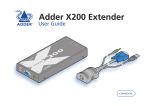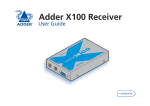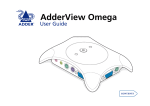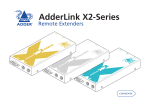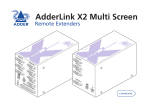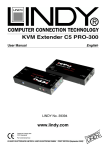Download ADDER AdderLink X100 User guide
Transcript
Adder X100 Extender Set T O LO C A L PO W ER User Guide TE MO RE R DE ® AD Further information Getting assistance.......................................................................15 Warranty.....................................................................................16 Safety information.....................................................................16 Radio Frequency Energy............................................................17 welcome Connections..................................................................................4 Cable length advice.................................................................4 Connections at the CAM (local) unit......................................5 Connections at the X100 (remote) module............................6 Operation......................................................................................8 General use..............................................................................8 Locking and unlocking the system.........................................8 installation & operation Installation & Operation Configuration...............................................................................9 What are hotkeys?..............................................................9 Entering, using and exiting configuration mode..............9 Password setting....................................................................10 Hot plugging and mouse restoration...................................11 Which restore setting do I use?........................................11 Microsoft and Logitech -specific mouse settings.................11 Video compensation (sharpness and brightness).................12 Miscellaneous settings...........................................................13 Performing flash upgrades........................................................14 special configuration Introduction..................................................................................2 Special configuration Welcome contents Contents PS/2 mouse connection Video connection Audio connection Brightness control Sharpness control PS/2 keyboard connection PS/2 mouse connection Video connection Audio connection* USB connection e.g. X100 or X100A X100A -PS2/P -PS2/P -USB/P -PS2/P or -USB/P PC PS/2 MOUSE X100 CAM PS/2 KEYBOARD VIDEO AUDIO* PSU welcome PS/2 keyboard connection X100A installation & operation X100 special configuration Special circuitry within the remote module allows you to make adjustments to the sharpness and brightness settings to suit your own preferences. Two types of remote X100 modules are available and two types of local CAMs can be chosen. These local and remote modules can be used in varying combinations to suit your requirements. The long distance link between the modules is made via Category 5, 5e or 6 twisted pair cabling. Thank you for choosing the Adder X100 extender set. These compact modules allow you to place the controlling keyboard, video monitor and mouse more than 100 metres from a computer system. The range topping X100A module also allows you to extend your audio accessories away from your computer. USB Introduction contents Welcome * only when supplied with X100A Note: CAMs with connections suitable for Sun Computers are available under special order. welcome Computer Access Module (CAM) Package variants X100-PS2/P Standard X100 with PS/2-style CAM X100-USB/P Standard X100 with USB CAM Power adapter and countryspecific power lead installation & operation Audio-equipped X100 with PS/2-style CAM Audio-equipped X100 with USB CAM Four self-adhesive rubber feet CD-ROM special configuration X100A-PS2/P X100A-USB/P X100 Module contents Supplied items Installation & Operation Category 5 Category 5e or 6 100m ¹ 50 to 100m ¹ ¹ length limited by skew in the cable. contents welcome installation & The X100 modules support twisted-pair structured cabling within categories 5, 5e and 6. Of these three cable types, category 5 generally provides the best transmission of video signals because its four pairs of conductors are the most evenly twisted. Category 5e and 6 cables use conductor pairs that are unevenly twisted in order to combat interference effects encountered within higher frequency networks. While these uneven twists work well for Ethernet signals, they can impose problems for the video signals transceived by the X100 modules. The X100 modules send the red, green and blue video signals on separate twisted pairs within the cable. If any of the colour signals are made to travel slightly further or shorter distances than the others, the result is seen as mis-aligned colours on screen. This is called skew and becomes more noticeable as cable runs become longer and screen resolutions/refresh rates increase. As an approximate guide, you should expect the following maximum cable lengths (achievable at resolutions up to 1600 x 1200 @ 60Hz): special configuration Installation of the X100 modules is straightforward and minimal configuration requirements in most cases. The moulded CAM (Computer Access Module) connects directly to the system, while the remote X100 module is at the other end of the twisted pair cable and attaches to the keyboard, mouse, etc. • Connections at the CAM (local) unit • Connections at the X100 (remote) module Cable length advice Connections Connections at the CAM (local) unit Green indicator - power present Yellow indicator - signal activity Computer Access Module USB keyboard/mouse Video 3 Lay a suitable length of category 5, 5e or 6 cabling between the computer system and the remote peripherals - see Cable length advice. Category 5, 5e or 6 cable to X100 module Note: CAMs derive power from the computer system via either the PS/2-style keyboard connector or USB connector. installation & Audio special configuration PS/2-style keyboard welcome PS/2-style mouse A range of different connector combinations are made available by the various CAM formats 4 Attach the connector of the cable run to the socket of the CAM. The other end of the cable run will attach to the remote X100 module. contents 1 Where possible ensure that power is disconnected from the system to be connected. (Note: If it is not possible to switch off devices prior to connection, then a ‘Hot plug’ procedure is available – see the Hot plugging and mouse restoration section for more details). 2 Locate the required CAM and attach its video, keyboard and mouse (PS/2style or USB) and optional audio connectors to the relevant sockets on the computer system. Connections at the X100 (remote) module R ® 3 Attach the connector of the cable run leading from the CAM to the TO LOCAL socket of the X100. ww d w.a de o r.c m 1 Place the X100 module adjacent to the remote user location. 2 Attach the video monitor, keyboard, mouse (and, optionally for X100A users, speaker) connectors to the sockets of the Adder X100 module. T O LO C A PO W ER contents L Category 5, 5e or 6 cable leading to the CAM module From power adapter 4 (X100A models only) Insert the speaker connector to the light green coloured socket situated between the link connector and the power in socket. 5 Insert the output connector of the power supply into the socket at the front edge of the X100 module labelled POWER. 6 Insert the IEC connector of the supplied power lead into the corresponding socket of the power supply. Connect the other end of the power lead to a nearby mains socket. 7 Where necessary, use the in-built video compensation feature to eliminate any effects caused by the cable run. See Video compensation for details. installation & From speakers (X100A models only) Adder X100 module special configuration From video monitor Adder X100 module From keyboard welcome From mouse X100 module switches 34 Reserved for future use Determines configuration of hotkeys in conjunction with switch 2 ON 1 2 34 Note: When shipped, all switches are set in the OFF positions and this will produce normal operation. Switches 2 and 3 Switches 2 and 3 determine which two keyboard keys (when pressed in unison) are to be designated as ‘hotkeys’. Hotkeys signal to the X100 module that the next key to be pressed is a special configuration command for the module and is not to be passed to the computer system. 2 OFF 3 OFF Hotkeys = CTRL and SHIFT 2 OFF 3 ON Hotkeys = ALT and SHIFT 2 ON 3 OFF Hotkeys = CTRL and ALT 2 ON 3 ON Hotkeys disabled Switch 4 This switch is reserved for future use. welcome 2 installation & 1 special configuration O ON N OFF: Normal operation ON: Flash upgrade Switch 1 OFF: Normal operation. ON: (Before power is applied) Places the X100 module into flash upgrade mode so that the internal software can be changed. Please see the Flash upgrade section in the ‘Special configuration’ chapter. Determines configuration of hotkeys in conjunction with switch 3 contents Certain aspects of operation can be affected by the switches on the X100 module. Operation To unlock the system . 1 Enter the correct password and press Note: Passwords are NOT case sensitive. Note: If an invalid password has been entered and the keyboard indicators are not flashing as described above, press to clear the incorrect attempt. 2 If the correct password is entered, the screen will be restored and normal operation can continue. To enable the video Simultaneously press the currently configured hotkeys (by default, long with . This command will be required to restore the video if along with is used when no password has been set. To disable the video Simultaneously, press the currently configured hotkeys (by default, along with . and ) and and ) installation & welcome To lock the system 1 First set a password. For further details, please refer to the Password setting section in the ‘Special configuration’ chapter. 2 Simultaneously press the currently configured hotkeys (by default, and ) along with . The screen will go blank and the three keyboard l rol ScLock indicators will begin alternately flashing between the ps CaLock ‘Num Lock’ and ‘Scroll Lock’, and ‘Caps Lock’. This m NuLock sequence indicates that a password is required. contents In situations where the computer system (and its local CAM) can be locked away the X100 modules offer a viable security system to deter unauthorised use. Once a password has been set, a simple key sequence allows the system to be quickly and securely detached from its peripherals. Only the correct password will reconnect the remote and local modules. special configuration In use, the X100 modules should be transparent - the system and its peripherals should operate exactly as normal, the only difference being that they are now up to 100 metres or more apart. In some installations, you may see some ‘shadows’ to the right of high contrast screen characters. This can be caused by an incorrectly selected sharpness setting and it may be necessary to make adjustments to correct this. Please see Video compensation - sharpness and brightness in the ‘Special configuration’ section. Locking and unlocking the system General use Special configuration Hotkeys are two normal keyboard keys that, when pressed simultaneously with a third key, signal to the X100 modules that you are sending a message specifically to them and not to the computer. The hotkeys are ordinarily and , while a third keypress determines what you want the modules to do. If the standard and hotkeys are also needed for computer tasks, you can change them for another combination using switches 2 and 3 on the X100 remote module: 2 OFF 3 OFF Hotkeys = and (default setting) 2 OFF 3 ON Hotkeys = and 2 ON 3 OFF Hotkeys = 2 ON 3 ON Hotkeys disabled and 2 Press the first letter of the required configuration option, for instance . All three keyboard indicators will illuminate continuously. 3 Press the number of the required configuration option, for instance . The ‘Scroll Lock’ indicator will extinguish, leaving the ‘Num Lock’ and ‘Caps Lock’ indicators lit. contents ps CaLock l rol ScLock welcome To enter and use configuration mode: 1 Simultaneously press the currently configured hotkeys (by default, and ) along with . The three keyboard indicators (‘Num Lock’, ‘Caps Lock’ and ‘Scroll Lock’) will now begin to flash in sequence to show that you are in configuration mode. m NuLock ps CaLock l rol ScLock m NuLock 4 Press to confirm your option. The three keyboard indicators (‘Num Lock’, ‘Caps Lock’ and ‘Scroll Lock’) will now begin to flash in sequence again. To exit from configuration mode: 1 Within configuration mode, the three keyboard indicators should be flashing in sequence to show that the module is ready to receive a new command. 2 Press . The three indicators will return to their normal states. installation & What are hotkeys? Entering, using and exiting configuration mode special configuration You can alter the way that the X100 modules operate to suit your requirements. This is done using the Configuration mode and you can affect the following settings: • Password setting – allows you to lock the remote module to prevent unauthorised system access. • Mouse restoration and settings – allows you to restore mouse operation and also to change the mouse type. • Video compensation - sharpness & brightness – allows you to manually adjust the video image to ensure that it is crisp and bright. • Miscellaneous settings – report firmware version and restore settings. Configuration Password setting welcome installation & special configuration To set a password and ) along with 1 Simultaneously, press the hotkeys (by default, to enter configuration mode. 2 Press followed by . 3 Now enter your new password, within the following constraints: • Passwords are NOT case sensitive, • Passwords may be any length from one character to a maximum of forty characters, • The following keys may NOT be used: , , , or to signal its completion. 4 When you have entered the password, press 5 Press once more to exit configuration mode. For full details about how to lock and unlock the system using your password, please see the Locking and unlocking the system section in the ‘Installation and operation’ chapter. contents Password protection allows you restrict access to the system only to authorised personnel. A password first needs to be set and then, using the keyboard attached to the remote X100 module, a simple key sequence allows the system to be quickly and securely detached from its peripherals. 10 Recognising an Intellimouse-style mouse The Intellimouse format was introduced to support, among other features, the scroll wheel function. If your mouse has a scroll wheel, then it is likely to support the Intellimouse format. If you have a Microsoft mouse, then it will usually state that it is an Intellimouse on its underside label. Recognising an Intellimouse driver Before hot plugging your X100 modules (or afterwards using only keyboard control), access the Windows Control Panel and select either the Mouse option (on Windows NT, 2000 and XP) or the System option (on Windows 95, 98, ME). Look for the name of the driver, which will usually include the words PS/2 or Intellimouse. Microsoft and Logitech -specific mouse settings welcome In certain installations some Logitech mouse drivers may lose the action of the mouse buttons when used with the standard ‘Microsoft compatible’ signalling protocol used between the modules. To solve this problem, select the ‘Logitech compatible’ mouse signalling protocol. installation & The general rule is that unless both the mouse and the driver are both Intellimouse compatible then you need to restore the mouse as ‘PS/2’. To change mouse signalling protocols 1 Simultaneously, press the hotkeys (by default, to enter configuration mode. 2 Enter the appropriate protocol code: • Microsoft compatible – press • Logitech compatible – press special configuration Which restore setting do I use? To restore mouse operation when hot plugging: 1 Carefully connect the X100 modules to the system and its keyboard, mouse, monitor and speakers. and ) along with 2 Simultaneously, press the hotkeys (by default, to enter configuration mode. 3 Enter the appropriate restore function code: • PS/2 – press • IntelliMouse – press 4 To exit configuration mode, press . 5 Move the mouse a short distance and check for appropriate on-screen cursor movement. If the mouse cursor darts erratically around the screen, then cease moving the mouse. This is an indication that the chosen restore function is incorrect. Try again using the other restore function. Note: The restore functions predict the likely mouse resolution settings but may not restore the exact speed or sensitivity settings that were originally set. 3 To exit configuration mode, press and ) along with . It is strongly recommended that you switch off the computer system before attempting to connect it via the X100 modules. However, if this is not possible then you need to ‘hot plug’ the X100 modules while power is still applied to the system. There is not normally a danger of damage to the system, however, when mouse communications are interrupted, often they fail to reinitialise when reconnected. X100 modules provide a feature to reinstate mouse communications once the necessary connections have been made. There are two main types of data formats used by current PC mice, these are the older ‘PS/2’ format and the more recent ‘IntelliMouse® ’ format introduced by Microsoft. These use slightly different data arrangements and it is important to know which type was being used before you hot-plugged the X100 modules. The previous setting depends both on the type of mouse and the type of driver as various combinations of PS/2 and Intellimouse are possible. Using the incorrect restore function may produce unpredictable results and require the system to be rebooted. contents Hot plugging and mouse restoration 11 for adjustment. There are 255 brightness levels. Sharpness increase (coarse) Restore default sharpness and brightness settings Sharpness decrease (coarse) Sharpness increase (fine) Exit image controls and save settings Brightness decrease Brightness increase Sharpness decrease (fine) 3 When no shadows are visible and the displayed images have crisp edges, press to exit configuration mode and permanently save all settings. The new compensation settings will be stored, even when power is removed or if a complete reset is initiated. These settings should not require further changes unless the cabling arrangements are altered. welcome installation & Brightness: special configuration To display a suitable high contrast image The best way to clearly view the effect of sharpness and brightness adjustments is to display a high contrast image, with vertical edges, on the screen. • Open a word processor, type the capital letter ‘H’, or ‘M’ and increase the point size to 72 High contrast Black or bright or higher. For best results, the background black character white shadow should be white and the character should be on white on the right background indicates black. the need for sharpness • A black shadow on the right of the character adjustment indicates under compensation. • A white shadow on the right of the character indicates over compensation. Note: The Word processor method is accurate and quick. However, for the very finest video compensation, use the latest Adder “skew” test pattern program which shows both the skew pattern and a section of mixed size Hs (black on white and white on black). To apply remote user video compensation 1 On the keyboard that is connected to the X100 remote module, simultaneously, press the hotkeys (by default, and ) along with to enter configuration mode. The three keyboard indicators (‘Num Lock’, ‘Caps Lock’ and ‘Scroll Lock’) will now begin to flash in sequence. The speed of the sequence indicates the level of the sharpness adjustment currently applied: the slower the rate, the lower the level of sharpness being applied. 2 While viewing the displayed screen image, use the following keys to adjust the controls: Sharpness: for fine adjustment, for coarse adjustment. There are 255 sharpness levels (one coarse step jumps 10 levels). To autoset sharpness: Press to make the module calculate and apply an automatic compensation level - you can use this as a starting point for your fine tuning. Note: If the monitor goes blank and switches off (due to oversetting the sharpness adjustment) press the Home key to restore. Using the in-built X100 controls you can adjust the picture sharpness and brightness to improve the remote picture quality. Video compensation is best carried out when viewing high contrast images with vertical edges, such as black lines on a white background. When doing so, if you notice that the screen image is ‘fuzzy’ or ‘dark’ then the image controls may not be able to solve this condition. contents Video compensation (sharpness and brightness) 12 Miscellaneous settings welcome installation & special configuration Reset all configuration options to default states - Returns all user configurable options to the settings that are installed at manufacture. The password will be cleared, however, any current image control settings or skew adjustments will not be reset. Report X100-series firmware version Before initiating this command, ensure that the system is running an application that can display typed keys as screen characters - e.g. a word processor or Windows Notepad. The current firmware version will be written to the application in the form of the letter ‘V’ followed by three numbers - for example V201 means version 2.01. contents The following are configuration settings within the modules that are not covered in other sections of this guide. These can be achieved once within configuration mode by pressing the indicated keys: 13 welcome installation & special configuration The Adder X100 modules and CAMs are fully reconfigurable via flash upgrades using the KVM Firmware Uploader utility. During the upgrade you will be required to connect the X100 module directly to a computer system using a special cable. The upgrade utility will update the firmware of the X100 and also temporarily transform it so that it can update the CAM unit. Once completed, the X100 will return to its normal operation. The KVM Firmware Uploader utility is available from the Adder Technology website (www.adder.com) and allows you to check the current revision of the X100 firmware. Full instructions are provided with the download file. contents Performing flash upgrades 14 Further information • Adder Technology website – www.adder.com Check the Support section of our website for the latest solutions and driver files. contents Getting assistance • Phone in the UK: in the US: 01954 780044 +1 888 932 3337 installation & 01954 780081 +1 888 275 1117 special configuration in the UK: in the US: further information • Fax welcome • Email – [email protected] 15 contents welcome installation & • For use in dry, oil free indoor environments only. •Do not use to link between buildings. • Ensure that all twisted pair interconnect cables are installed in compliance with all applicable wiring regulations. •Do not connect CATx link interfaces (RJ45 style connectors) to any other equipment, particularly network or telecommunications equipment. • Warning – the power adapter contains live parts. • No user serviceable parts are contained within the power adapter - do not dismantle. • Plug the power adapter into a socket outlet close to the X100 module that it is powering. • Replace the power adapter with a manufacturer approved type only. •Do not use the power adapter if the power adapter case becomes damaged, cracked or broken or if you suspect that it is not operating properly. • If you use a power extension cord with the X100 module, make sure the total ampere rating of the devices plugged into the extension cord do not exceed the cord’s ampere rating. Also, make sure that the total ampere rating of all the devices plugged into the wall outlet does not exceed the wall outlet’s ampere rating. •Do not attempt to service the modules yourself. • The X100 module and power supply can get warm in operation – do not situate them in an enclosed space without any ventilation. • The X100 module does not provide ground isolation and should not be used for any applications that require ground isolation or galvanic isolation. special configuration Adder Technology Ltd warrants that this product shall be free from defects in workmanship and materials for a period of two years from the date of original purchase. If the product should fail to operate correctly in normal use during the warranty period, Adder will replace or repair it free of charge. No liability can be accepted for damage due to misuse or circumstances outside Adder’s control. Also Adder will not be responsible for any loss, damage or injury arising directly or indirectly from the use of this product. Adder’s total liability under the terms of this warranty shall in all circumstances be limited to the replacement value of this product. If any difficulty is experienced in the installation or use of this product that you are unable to resolve, please contact your supplier. Safety information further information Warranty 16 Canadian Department of Communications RFI statement This equipment does not exceed the class A limits for radio noise emissions from digital apparatus set out in the radio interference regulations of the Canadian Department of Communications. Le présent appareil numérique n’émet pas de bruits radioélectriques dépassant les limites applicables aux appareils numériques de la classe A prescrites dans le règlement sur le brouillage radioélectriques publié par le ministère des Communications du Canada. welcome This equipment generates, uses and can radiate radio frequency energy and if not installed and used properly, that is, in strict accordance with the manufacturer’s instructions, may cause interference to radio communication. It has been tested and found to comply with the limits for a class A computing device in accordance with the specifications in Subpart J of part 15 of FCC rules, which are designed to provide reasonable protection against such interference when the equipment is operated in a commercial environment. Operation of this equipment in a residential area may cause interference, in which case the user at his own expense will be required to take whatever measures may be necessary to correct the interference. Changes or modifications not expressly approved by the manufacturer could void the user’s authority to operate the equipment. installation & This equipment has been tested and found to comply with the limits for a class A computing device in accordance with the specifications in the European standard EN55022. These limits are designed to provide reasonable protection against harmful interference. This equipment generates, uses and can radiate radio frequency energy and if not installed and used in accordance with the instructions may cause harmful interference to radio or television reception. However, there is no guarantee that harmful interference will not occur in a particular installation. If this equipment does cause interference to radio or television reception, which can be determined by turning the equipment on and off, the user is encouraged to correct the interference with one or more of the following measures: (a) Reorient or relocate the receiving antenna. (b) Increase the separation between the equipment and the receiver. (c) Connect the equipment to an outlet on a circuit different from that to which the receiver is connected. (d) Consult the supplier or an experienced radio/TV technician for help. FCC Compliance Statement (United States) special configuration European EMC directive 89/336/EEC further information A Category 5 (or better) twisted pair cable must be used to connect the units in order to maintain compliance with radio frequency energy emission regulations and ensure a suitably high level of immunity to electromagnetic disturbances. All other interface cables used with this equipment must be shielded in order to maintain compliance with radio frequency energy emission regulations and ensure a suitably high level of immunity to electromagnetic disturbances. contents Radio Frequency Energy 17 contents installation & special configuration Adder Corporation, 29 Water Street, Newburyport, MA 01950, United States of America Tel: +1-888-932-3337 Fax: +1-888-275-1117 further information Adder Technology Limited, Technology House, Trafalgar Way, Bar Hill, Cambridge, CB3 8SQ, United Kingdom Tel: +44 (0)1954 780044 Fax: +44 (0)1954 780081 welcome © 2006 Adder Technology Limited All trademarks are acknowledged. Release 1.0b December 2006 Part No. ADD0067 Documentation by: www.ctxd.com 18



















